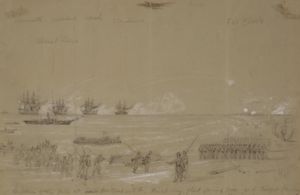By the dawn of the Civil War, the schooling of America’s children is no longer in the strong grip of Protestant Christians.
Following the formation of the United States of America and the enactment of church state separation, as well as Thomas Jefferson’s plea for a common education system for all, Protestant Christians nonetheless maintained a dominant influence in the education of children in America. Until the 1830s, private schoolmasters and sectarian-run schools remained the norm. Yet Protestants, a widely-diverse lot by the 1830s, could not agree on education principles and methodology, and began looking to local and state governments to furnish common education. At the same time, Horace Mann, a Massachusetts lawyer, began advocating for universal education directed by government. Thirty years later, government-led universal education is well under way.
Today, far from the war front, the ongoing shaping of modern education in America is reflected in a meeting held at the First Baptist Church of Rochester, Minnesota.
The story begins in 1857, with the formation of Minnesota as a state. Obtaining statehood, the legislature proceeded to create “what was then the largest permanent school fund in the nation to support Minnesota’s newly established public school system.” Now Minnesota’s educators gather at First Baptist Rochester to take the next step: the formation of the Minnesota State Teachers Association, forerunner of the Minnesota Education Association. From the teachers’ union that results from this meeting, the first tenure laws for Minnesota teachers soon emerge. In the larger perspective, the continued development of government education systems in the North during the war years paves the way for education models that are brought to bear in the devastated, post-War South.
Meanwhile, as Minnesota educators meet and chart their future, Union forces begin an assault upon North Carolina. Bombarding the Confederates’ Fort Hatteras and Fort Clark off the North Carolina coast, the Union Navy captures the forts two days hence, creating an opening to the eastern portion of the state. The entire southern coastline is vulnerable to the superior Navy of the Union, as time will repeatedly reveal.
Sources: Minnesota educators’ meeting (link); Union capture of Fort Hatteras and Clark, story and image (link) and (link)



